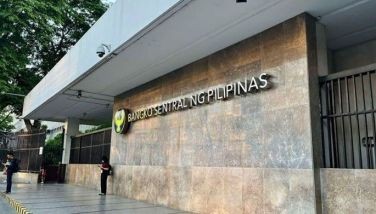BSP issues guidelines on bank intervention
March 31, 2006 | 12:00am
The Bangko Sentral ng Pilipinas (BSP) has issued new guidelines allowing it to intervene in problem banks as soon as they start showing early signs of failure.
The Monetary Board approved the guidelines that will enable the BSP to take prompt corrective action on banks and other supervised financial institutions. The enforcement of prompt corrective action (PCA), according to the BSP, would attempt to restore a bank found in its early stages of non-compliance with standard conditions/ratings, to return to normal operations within a reasonable period of time.
"This will avoid the imposition of harsher measures usually instituted when the entity is in its advanced stages of deterioration," said BSP Governor Amando M. Tetangco Jr.
Tetangco said the policy guidelines would update previous BSP rules and regulations on PCA, in light of the changing financial environment in which its supervised entities operates and the adoption by the BSP of internationally-accepted standards in its supervision.
According to Tetangco, the most significant change introduced in the enforcement of PCA was the prescription of multiple criteria that could trigger the enforcement of the PCA.
"Previous regulations limited the same to the level of undercapitalization," he explained.
Under the new guidelines, Tetangco said the BSP will also observe other indications that are potentially reflective of the condition of a bank or financial institution, to determine whether they constituted the "trigger events" for the enforcement of the PCA.
Considering that the concept of risk-based capital for banks has been adopted pursuant to the Basel Capital Accord, Tetangco said the BSP would use relevant indicators, such as risk-weighted capital ratios and CAMELS ratings as alternative criteria for determining PCA trigger events.
Under the new guidelines, Tetangco said a bank could be subject to PCA when any of its prescribed capital ratios falls below the minimum requirement.
This includes the bank’s capital adequacy ratio (CAR), Tier 1 risk-based ratio, or leverage ratio.
Tetangco said the BSP will also step in when a bank’s CAMEL composite rating or management component rating falls below 3.
Finally, Tetangco said the BSP would start considering it a PCA trigger whenever "a serious supervisory concern has been identified that places the bank at more-than-normal risk of failure." According to Tetangco, the new guidelines also broaden the measures that may be taken as PCA, in order to more comprehensively address the identified deficiencies of a bank or supervised financial institution.
These measures include the implementation of a capital restoration plan, business improvement plan, and corporate governance reforms.
The BSP chief said the overall plan would be documented in a Memorandum of Understanding (MOU) that a financial institution’s board of directors will enter into with the BSP.
"In order to impress upon the supervised financial institutions the seriousness of
PCA as BSP’s course of action, the guidelines also provide sanctions for unreasonable delay in entering into and non-compliance with, the PCA plan," he added.
Conversely, Tetangco said the guidelines also spell out the conditions for lifting of the PCA status and granting special exceptions for access to BSP credit facilities, in case of compliance with the PCA plan.
"The BSP hopes that the new PCA guidelines, by promoting early intervention before bigger problems arise, will be an effective instrument in maintaining a stable financial system and preserving confidence therein," Tetangco said.
The Monetary Board approved the guidelines that will enable the BSP to take prompt corrective action on banks and other supervised financial institutions. The enforcement of prompt corrective action (PCA), according to the BSP, would attempt to restore a bank found in its early stages of non-compliance with standard conditions/ratings, to return to normal operations within a reasonable period of time.
"This will avoid the imposition of harsher measures usually instituted when the entity is in its advanced stages of deterioration," said BSP Governor Amando M. Tetangco Jr.
Tetangco said the policy guidelines would update previous BSP rules and regulations on PCA, in light of the changing financial environment in which its supervised entities operates and the adoption by the BSP of internationally-accepted standards in its supervision.
According to Tetangco, the most significant change introduced in the enforcement of PCA was the prescription of multiple criteria that could trigger the enforcement of the PCA.
"Previous regulations limited the same to the level of undercapitalization," he explained.
Under the new guidelines, Tetangco said the BSP will also observe other indications that are potentially reflective of the condition of a bank or financial institution, to determine whether they constituted the "trigger events" for the enforcement of the PCA.
Considering that the concept of risk-based capital for banks has been adopted pursuant to the Basel Capital Accord, Tetangco said the BSP would use relevant indicators, such as risk-weighted capital ratios and CAMELS ratings as alternative criteria for determining PCA trigger events.
Under the new guidelines, Tetangco said a bank could be subject to PCA when any of its prescribed capital ratios falls below the minimum requirement.
This includes the bank’s capital adequacy ratio (CAR), Tier 1 risk-based ratio, or leverage ratio.
Tetangco said the BSP will also step in when a bank’s CAMEL composite rating or management component rating falls below 3.
Finally, Tetangco said the BSP would start considering it a PCA trigger whenever "a serious supervisory concern has been identified that places the bank at more-than-normal risk of failure." According to Tetangco, the new guidelines also broaden the measures that may be taken as PCA, in order to more comprehensively address the identified deficiencies of a bank or supervised financial institution.
These measures include the implementation of a capital restoration plan, business improvement plan, and corporate governance reforms.
The BSP chief said the overall plan would be documented in a Memorandum of Understanding (MOU) that a financial institution’s board of directors will enter into with the BSP.
"In order to impress upon the supervised financial institutions the seriousness of
PCA as BSP’s course of action, the guidelines also provide sanctions for unreasonable delay in entering into and non-compliance with, the PCA plan," he added.
Conversely, Tetangco said the guidelines also spell out the conditions for lifting of the PCA status and granting special exceptions for access to BSP credit facilities, in case of compliance with the PCA plan.
"The BSP hopes that the new PCA guidelines, by promoting early intervention before bigger problems arise, will be an effective instrument in maintaining a stable financial system and preserving confidence therein," Tetangco said.
BrandSpace Articles
<
>
- Latest
- Trending
Trending
Latest


























